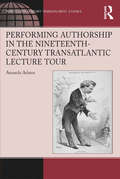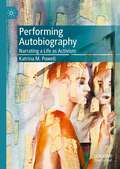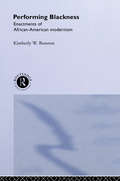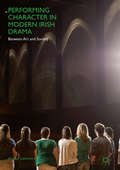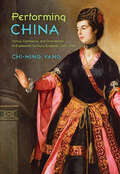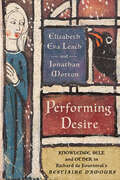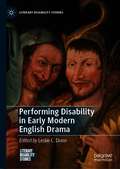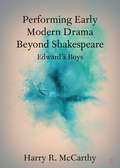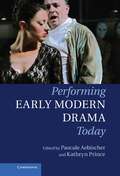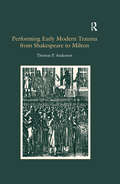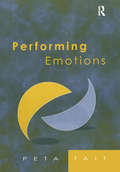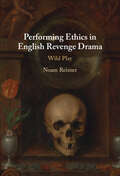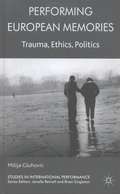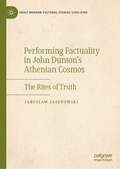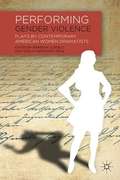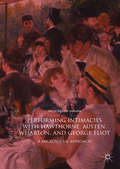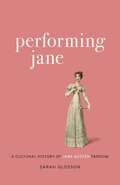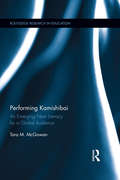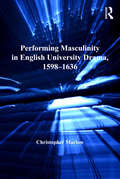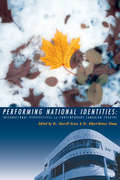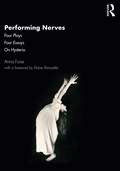- Table View
- List View
Performing Authorship in the Nineteenth-Century Transatlantic Lecture Tour (Ashgate Series in Nineteenth-Century Transatlantic Studies)
by Amanda AdamsExpanding our understanding of what it meant to be a nineteenth-century author, Amanda Adams takes up the concept of performative, embodied authorship in relationship to the transatlantic lecture tour. Adams argues that these tours were a central aspect of nineteenth-century authorship, at a time when authors were becoming celebrities and celebrities were international. Spanning the years from 1834 to 1904, Adams’s book examines the British lecture tours of American authors such as Frederick Douglass, Harriet Beecher Stowe, and Mark Twain, and the American lecture tours of British writers that include Harriet Martineau, Charles Dickens, Oscar Wilde, and Matthew Arnold. Adams concludes her study with a discussion of Henry James, whose American lecture tour took place after a decades-long absence. In highlighting the wide range of authors who participated in this phenomenon, Adams makes a case for the lecture tour as a microcosm for nineteenth-century authorship in all its contradictions and complexity.
Performing Autobiography
by Jennifer StephensonIn Performing Autobiography, Jenn Stephenson presents an innovative new approach to autobiography studies that links the growing field of research to drama. Stephenson's analysis engages with performance histories to demonstrate the extent to which the dramatic form, which recasts autobiography as ambiguously fictive, ensures that the experience of the plays remains open to revision, alteration, and interpretation. As such, Performing Autobiography understands this form not to be the impossible documentation of the backward-looking narrative of one's life, but rather an evolving process of self-creation and transformation.Stephenson explores the autobiographical form by analysing seven works by Canadian playwrights written and performed between 1999 and 2009, including Judith Thompson's Perfect Pie, Daniel MacIvor's In On It, and Timothy Findley's Shadows. Her analysis encourages us to see autobiography as a uniquely political act, one that, where enacted on stage, illustrates the variety of ways that self-reflection and interpretation has an expanding role in contemporary culture.
Performing Autobiography: Narrating a Life as Activism
by Katrina M. PowellPerforming Auto/biography: Narrating a Life as Activism analyzes the rhetorical strategies employed in five authors’ auto/biographical texts, examining their representations of identities and the public implications of writing individual identity. Exploring the ways race, class, culture, ethnicity, gender, and sexuality might affect the form(s) in which writers choose to write (e.g., memoir, fictional autobiography, poetry), questions how autobiographers challenge notions of genre, truth, and representation. This builds on the argument that constructing identity is a Performing Autobiography performance, one that can simultaneously use and subvert traditional notions of rhetoric and genre. By examining the auto/biographical texts of Zora Neale Hurston, Audre Lorde, Dorothy Allison, Joyce Johnson, and Shirley Geok-lin Lim together, the book theorizes self-representation and genres as rhetorical performances, and therefore their texts can be seen as “performative auto/biography”—transgressive archives where readers are asked to consider their own identities and act accordingly. In doing so, this book contributes to growing theories in feminist rhetorics and auto/biography studies, arguing that these performative genres advocate for life narratives as political and social activism.
Performing Blackness: Enactments of African-American Modernism
by Kimberley W. BenstonPerforming Blackness offers a challenging interpretation of black cultural expression since the Black Arts Movement of the 1960s. Exploring drama, music, poetry, sermons, and criticism, Benston offers an exciting meditation on modern black performance's role in realising African-American aspirations for autonomy and authority. Artists covered include: * John Coltrane* Ntozake Shange * Ed Bullins * Amiri Baraka * Adrienne Kennedy * Michael Harper. Performing Blackness is an exciting contribution to the ongoing debate about the vitality and importance of black culture.
Performing Bodies in Pain
by Marla CarlsonThis text analyzes the cultural work of spectacular suffering in contemporary discourse and late-medieval France, reading recent dramatizations of torture and performances of self-mutilating conceptual art against late-medieval saint plays.
Performing Character in Modern Irish Drama: Between Art And Society
by Michał LachmanThis book is about the history of character in modern Irish drama. It traces the changing fortunes of the human self in a variety of major Irish plays across the twentieth century and the beginning of the new millennium. Through the analysis of dramatic protagonists created by such authors as Yeats, Synge, O’Casey, Friel and Murphy, and McGuinness and Walsh, it tracks the development of aesthetic and literary styles from modernism to more recent phenomena, from Celtic Revival to Celtic Tiger, and after.The human character is seen as a testing ground and battlefield for new ideas, for social philosophies, and for literary conventions through which each historical epoch has attempted to express its specific cultural and literary identity. In this context, Irish drama appears to be both part of the European literary tradition, engaging with its most contentious issues, and a field of resistance to some conventions from continental centres of avant-garde experimentation. Simultaneously, it follows artistic fashions and redefines them in its critical contribution to European artistic and theatrical diversity.
Performing China: Virtue, Commerce, and Orientalism in Eighteenth-Century England, 1660–1760
by Chi-ming YangChina in the seventeenth and eighteenth centuries was a model of economic and political strength, viewed by many as the greatest empire in the world. While the importance of China to eighteenth-century English consumer culture is well documented, less so is its influence on English values. Through a careful study of the literature, drama, philosophy, and material culture of the period, this book articulates how Chinese culture influenced English ideas about virtue. Discourses of virtue were significantly shaped by the intensified trade with the East Indies. Chi-ming Yang focuses on key forms of virtue—heroism, sincerity, piety, moderation, sensibility, and patriotism—whose meanings and social importance developed in the changing economic climate of the period. She highlights the ways in which English understandings of Eastern values transformed these morals. The book is organized by type of performance—theatrical, ethnographic, and literary—and by performances of gender, identity fraud, and religious conversion. In her analysis of these works, Yang brings to light surprising connections between figures as disparate as Confucius and a Chinese Amazon and between cultural norms as far removed as Hindu reincarnation and London coffeehouse culture. Part of a new wave of cross-disciplinary scholarship, where Chinese studies meets the British eighteenth century, this novel work will appeal to scholars in a number of fields, including performance studies, East Asian studies, British literature, cultural history, gender studies, and postcolonial studies.
Performing Cities
by Nicolas WhybrowPerforming Cities is an edited volume of contributions by a range of internationally renowned academics and performance makers from across the globe, each one covering a particular city and examining it from the dynamic perspectives of performances occurring in cities and the city itself as performance.
Performing Desire: Knowledge, Self, and Other in Richard de Fournival's "Bestiaire d'amours"
by Elizabeth Eva Leach Jonathan MortonPerforming Desire examines the intellectual and philosophical complexity of a monument of medieval literature: the mid-thirteenth-century Bestiaire d'amours of Richard de Fournival. Although the Bestiaire was recognized in its time as significant, as evinced by numerous surviving manuscript copies and its influence on other literary works, modern scholarship has tended to neglect it. Performing Desire remedies this omission by detailing the contributions of the Bestiaire to medieval literature and thought.Attending to the phenomenology, psychology, and philosophy of Fournival's Bestiaire, Elizabeth Eva Leach and Jonathan Morton reconsider the work as a literary experiment that explores erotic desire and the construction of a self. Leach and Morton further show that the Bestiaire is as much a meditation on sound and performance as it is a study of desire. Synthesizing methods from musicology, literary studies, and manuscript studies, Leach and Morton consider the complex and hybridized workings of text, image, sound, and cues for performance in the surviving manuscripts of the Bestiaire. Through their analysis, Leach and Morton find that the distinctive aspect of the Bestiaire's philosophical method is its self-conscious status as a performance between the oral and the literary, the voice and the page. It is this aspect, they contend, that left such a mark on the medieval European tradition of philosophical fiction. In Performing Desire, Richard de Fournival's hybrid text emerges as one of the most philosophically sophisticated and important works of medieval literature not only in French but in any language.
Performing Disability in Early Modern English Drama (Literary Disability Studies)
by Leslie C. DunnPerforming Disability in Early Modern English Drama investigates the cultural work done by early modern theatrical performances of disability. Proffering an expansive view of early modern disability in performance, the contributors suggest methodologies for finding and interpreting it in unexpected contexts. The volume also includes essays on disabled actors whose performances are changing the meanings of disability in Shakespeare for present-day audiences. By combining these two areas of scholarship, this text makes a unique intervention in early modern studies and disability studies alike. Ultimately, the volume generates a conversation that locates and theorizes the staging of particular disabilities within their historical and literary contexts while considering continuity and change in the performance of disability between the early modern period and our own.
Performing Early Modern Drama Beyond Shakespeare: Edward's Boys (Elements in Shakespeare Performance)
by Harry McCarthyThis Element provides the first in-depth study of the present-day all-boy company, Edward's Boys, who are based at King Edward VI School ('Shakespeare's School') in Stratford-upon-Avon. Since 2005, the company has produced a wide array of early modern plays, providing the most substantial repertory of early modern drama available for examination by scholars. The Element provides a comprehensive account of the company's practices, drawing on extensive rehearsal and performance observation, evidence from the company's archive, and interviews with actors and key company personnel. The Element takes account of the company's particular educational and strongly interpersonal environment, suggesting that these factors have a distinctive shaping force on their performance practice. In the hands of Edward's Boys, the Element argues, early modern drama becomes the source of company creation, ensemble practice, and virtuosic physical play, inviting us to reimagine what it means – and takes – to perform these plays today.
Performing Early Modern Drama Today
by Pascale Aebischer Kathryn PrinceWhile much attention has been devoted to performances of Shakespeare's plays today, little has been focused on modern productions of the plays of his contemporaries, such as Marlowe, Webster and Jonson. Performing Early Modern Drama Today offers an overview of early modern performance, featuring chapters by academics, teachers and practitioners, incorporating a variety of approaches. The book examines modern performances in both Britain and America and includes interviews with influential directors, close analysis of particular stage and screen adaptations and detailed appendices of professional and amateur productions. Chapters examine intellectual and practical opportunities to analyse what is at stake when the plays of Shakespeare's contemporaries are performed by ours. Whether experimenting with original performance practices or contemporary theatrical and cinematic ones, productions of early modern drama offer an inspiring, sometimes unusual, always interesting perspective on the plays they interpret for modern audiences.
Performing Early Modern Trauma from Shakespeare to Milton
by Thomas P. AndersonAn examination of political and cultural acts of commemoration, this study addresses the way personal and collective loss is registered in prose, poetry and drama in early modern England. It focuses on the connection of representation of violence in literary works to historical traumas such as royal death, secularization and regicide. The author contends that dramatic and poetic forms function as historical archives both in their commemoration of the past and in their reenactment of loss that is part of any effort to represent traumatic history. Incorporating contemporary theories of memory and loss, Thomas Anderson here analyzes works by Shakepeare, Marlowe, Webster, Marvell and Milton. Where other studies about violent loss in the period tend to privilege allegorical readings that equate the content of art to its historical analogue, this study insists that artistic representations are performative as they commemorate the past. By interrogating the difficulty in representing historical crises in poetry, drama and political prose, Anderson demonstrates how early modern English identity is the fragile product of an ambivalent desire to flee history. This book's major contribution to Renaissance studies lies in the way it conceives the representations of violent loss-secular and religious-in early modern texts as moments of failed political and social memorialization. It offers a fresh way to understand the development of historical and national identity in England during the Renaissance.
Performing Emotions: Gender, Bodies, Spaces, in Chekhov's Drama and Stanislavski's Theatre
by Peta TaitIn Performing Emotions, Peta Tait's central argument is that performing emotions in realism is also performing gender identity. Emotions are phenomena that are performable by bodies, which have cultural identities. In turn, these create cultural spaces of emotions. This study integrates scholarship on realist drama, theatre and approaches to acting, with interdisciplinary theories of emotion, phenomenology and gender theory. With chapters devoted to masculinity and femininity specifically, as well as to emotions generally, it investigates social beliefs about emotions through Chekhov's four major plays in translation, and English language commentaries on Constantin Stanislavski's direction (of the play's first productions) and his approaches to acting, and Olga Knipper's acting of the central women characters. Emotions exists as social relationships; they are imagined and embodied as gendered. Tait demonstrates how theatrical emotions are predicated on social performances and vice versa. In Chekhov's plays, which came to dominate a twentieth century theatre of emotions, characters interpret their emotions intertextually in relation to other theatrical and fictional narratives of emotions. Tait here interrogates these plays as sustained explorations of the inherent theatricality of characters expressing emotions from their phenomenological awareness. A theatrical language of gendered interiority is produced in the acting of emotions in Stanislavski's early realistic theatre. Alternatively, remapping the performances of emotional bodies can destabilise the culturally constructed boundary separating an inner, private self and an outer, social self in culturally produced geographies of emotions. As Tait shows, emotions can be performed as indivisible spatialities. Performing Emotions integrates theories of theatre, gender identity and emotion to investigate how sexual difference impacts on the representations of emotions. The book develops an accumulative analysis of the meanings of emotions in twentieth century realist drama, theatre and acting.
Performing Ethics in English Revenge Drama: Wild Play
by Noam ReisnerAdapting Francis Bacon's notion of revenge as a 'kind of wild justice', Noam Reisner shows how English Renaissance revenge drama takes the form of 'wild play'. These plays drew on complicated modes of audience participation and devices of metatheatricality, allowing audiences to test how abstract moral or ethical concepts play out in a performative arena of human action. Reisner demonstrates that their overwhelming popularity is best understood in terms of these 'mimetic ethical exercises' which they generated for their audiences. This study surveys a range of revenge plays from the period's commercial theatre, beginning with Kyd's The Spanish Tragedy and tracking the development of similar plays responding to Kyd's original design in late Elizabethan and early Jacobean drama. In the process it also provides a stage history of Kydian revenge drama with fresh readings of select plays by Marlowe, Shakespeare, Marston, Middleton and other early Jacobean playwrights.
Performing European Memories
by Milija GluhovicAsking whether a genuinely shared European memory is possible while addressing the dangers of a single, homogenized European memory, Gluhovic examines the contradictions, specificities, continuities and discontinuities in the European shared and unshared pasts as represented in the works of Pinter, Tadeusz Kantor, Heiner Muller and Artur Zmijewski.
Performing Factuality in John Dunton’s Athenian Cosmos: The Rites of Truth (Early Modern Cultural Studies 1500–1700)
by Jaroslaw JasenowskiStarting from the fundamental epistemological shifts characterising the seventeenth century, this book explores the re-conceptualization of the notion of truth and asks how factuality, along with other truth-carrying discourses, was appropriated by a range of texts to generate credibility. Tracing the numerous ways in which authors such as John Dunton, Charles Gildon, François Perreaud, Thomas Brown, or Joseph Addison and Richard Steele deliberately toyed with the truth effects generated by their participation in discourses such as proto-science, medicine, philosophy, law and religion, this monograph argues that truth is not a monolithic constant. Performing Factuality proposes that truth is protean, ever- emerging from a simultaneously conventionalised yet constantly mutating set of practices, something which not simply is but something which is actively done. This performative dimension finds one of its most powerful examples in the case of Dunton and his handful of collaborators working on the Athenian Mercury, which set the tone in periodical publication for decades if not centuries to come.
Performing Gender Violence
by Barbara Ozieblo Noelia Hernando-RealViolence against women in plays bywomen has earned little mention. This revolutionary collection fills that gap, focusing on plays by American women dramatists, written in the last thirty years, that deal with different forms of gender violence. Each author discusses specific manifestations of violence in carefully selected plays: psychological, familial, war-time, and social injustice. This book encompasses the theatrical devices used to represent violence on the stage in an age of virtual, immediate reality as much as the problematics of gender violence in modern society.
Performing Greek Comedy
by Alan HughesAlan Hughes presents a new complete account of production methods in Greek comedy. The book summarizes contemporary research and disputes, on such topics as acting techniques, theater buildings, masks and costumes, music and the chorus. Evidence is re-interpreted and traditional doctrine overthrown. Comedy is presented as the pan-Hellenic, visual art of theater, not as Athenian literature. Recent discoveries in visual evidence are used to stimulate significant historical revisions. The author has directly examined 350 vase scenes of comedy in performance and actor-figurines, in 75 collections, from Melbourne to St Petersburg. Their testimony is applied to acting techniques and costumes, and women's participation in comedy and mime. The chapters are arranged by topic, for convenient reference by scholars and students of theater history, literature, classics and drama. Overall, the book provides a fresh practical insight into this continually developing subject.
Performing Intimacies with Hawthorne, Austen, Wharton, and George Eliot: A Microsocial Approach
by Maya Higashi WakanaPerforming Intimacies with Hawthorne, Austen, Wharton, and George Eliot analyzes literary reproductions of everyday intimacies through a microsociological lens to demonstrate the value of reading microsocially. The text investigates the interplay between author, character, and reader and considers such concepts as face and moments of embarrassment to emphasize how art and life are inseparable. Drawing on narrative theory, the phenomenological approach, and macro approaches, Maya Higashi Wakana examines Hawthorne’s “The Minister’s Black Veil,” Austen’s Pride and Prejudice, Wharton’s Ethan Frome and The Age of Innocence, and George Eliot’s The Mill on the Floss. Through a multidisciplinary approach, this book provides new ways of reading the everyday in literature.
Performing Jane: A Cultural History of Jane Austen Fandom
by Sarah GlossonJane Austen has resonated with readers across generations like no other writer. More than two hundred years after the publication of her most celebrated novel, Pride and Prejudice, people around the world continue to honor “dear Jane.” In Performing Jane, Sarah Glosson explores this vibrant fandom, examining a long history of Austen fans engaging with her work, from wearing hand-sewn bonnets and period-appropriate corsets to creating spirited fanfiction and comical gifsets. Sophisticated and engaging, this study demonstrates that Austen fans of today have a great deal in common with those who loved the English novelist long before the term “fan” came into use. Performing Jane analyzes three ways fans engage with Austen and her work: collecting material related to the writer, whether in physical scrapbooks or on social-media platforms; creating and consuming imitative works, including fanfiction and modernized adaptations such as The Lizzie Bennet Diaries; and making pilgrimages to Steventon, Hampshire, Chawton Cottage, and even to annual meetings of Jane Austen societies. Key to Glosson’s exploration of Austen fans is the notion that all of these activities, whether occurring in private or in public, are fundamentally performative. And in counterbalance to studies that center on fans with a tendency to transform and disrupt the original text, this study provides much-needed understanding of a fandom that predominantly reaffirms Austen’s works. Because Austen’s writing has bridged the realms of both literary and popular culture, this fandom serves as an excellent case study to understand the ways in which we draw distinctions between fandom and other forms of intensive engagement and, more importantly, to appreciate how fluid those distinctions can be. Performing Jane embraces a holistic view of the long history of Austen fandom, relying on archival research, literary and visual analyses, and ethnographic study. This groundbreaking book not only demonstrates the ways in which fan practices, today and in the past, are performative, but also provides fresh perspectives into fandom and contributes to our understanding of the ways readers engage with literature.
Performing Kamishibai: An Emerging New Literacy for a Global Audience (Routledge Research in Education)
by Tara McGowanKamishibai (paper-theater), a Japanese picture-storytelling medium, is gaining global interest as we move from a text-based culture to one that emphasizes multiple semiotic systems and performance. This is the first volume to explore the potential of kamishibai as a dynamic "new" interactive medium for teaching multimodal communication and shows how synchronizing oral, visual and gestural modes develops students’ awareness of all modes of communication as potential resources in their learning. By examining the multiple modes involved in kamishibai through actual student performances over several venues, this volume overturns commonly held expectations about literacy in the classroom and provides a critical perspective on assumptions about other media. It offers much-needed information about a medium that is attracting interest from educators, academics and artists worldwide.
Performing Masculinity in English University Drama, 1598-1636 (Studies In Performance And Early Modern Drama Ser.)
by Christopher MarlowReferencing early modern English play texts alongside contemporary records, accounts and statutes, this study offers an overdue assessment of the relationship between the dramatic efforts of the universities and early modern male identity. Taking into account the near single-sex constitution of early modern universities, the book argues that performances of university plays, and student responses to them, were key ways of exploring and shaping early modern masculinity. Christopher Marlow shows how the plays dealt with their academic and social contexts, and analyses their responses to competing versions of masculinity. He also considers the implications of university authority and royal patronage for scholarly performances of masculinity; the effect of the literary traditions of classical friendship and platonic love on academic representations of male behaviour; and the relationship between university drama and masculine initiation rituals. Including discussion of the Parnassus trilogy, Club Law and works by Thomas Randolph, William Cartwright, John Milton and others, this study shines new light on long neglected aspects of the golden age of English drama.
Performing National Identities
by Sherrill Grace Albert-Reiner GlaapA collection of eighteen original essays on contemporary Canadian theatre by scholars and drama specialists in Canada, Great Britain, Europe, Australia, Hungary, and Japan. The international scope of the volume, reflected in its co-editors (Sherrill Grace from Canada, Albert-Reiner Glaap from Germany), confirms the new importance of Canadian plays on the world stage.
Performing Nerves: Four Plays, Four Essays, On Hysteria
by Anna FurseAcademic interest in hysteria has burgeoned in recent decades. The topic has been probed by feminist theorists, cultural studies specialists, literary scholars, anthropologists, sociologists, psychologists, medical and art historians, as well as novelists. The hysteric is construed as a powerless, voiceless subject, marginalised by the forces of the patriarchy that have been the root cause of their distress, dissembling, and disablement. In Performing Nerves, Anna Furse interweaves her artistic and academic practice, drawing on her own performance texts to explore four different versions of debilitating hysteric suffering. Each text is extensively annotated, revealing the dramaturgical logic and, in turn, the historical, medical, and cultural contexts behind their protagonists' illnesses, which are argued as environmentally caused in each case. This unique, reflective insight into a playwright and director’s craft offers not only an account of how mental suffering can manifest in different contexts and times, from the 19th century to today, but also a breadth of access to the ideas that can motivate creative research. This book is an invaluable resource for scholars of theatre studies, performance studies, dramaturgy, 20th-century history, gender studies, and medical humanities.
